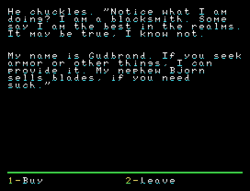Stealth Game Codex Review: Mark of the Ninja
Stealth Game Codex Review: Mark of the Ninja
Review - posted by Crooked Bee on Sun 25 November 2012, 16:35:24
Tags: Klei Entertainment; Mark of the NinjaHaving read JarlFrank's Dishonored review, our esteemed community member Mrowak, who you may remember for his Diablo III and Inquisitor articles, decided to counter it with reviewing what he considers to be a much better stealth game - namely, the recently released 2D stealth side-scroller Mark of the Ninja. Have a snippet:
Read the full article: Stealth Game Codex Review: Mark of the Ninja
The game features many types of foes, who possess a variety of abilities. Dogs can sniff you out from hiding spots, elite guards are impossible to stealth-kill unless stunned, heavy troopers carry riot shields which make them invulnerable to your normal attacks, snipers can spot you from afar in the total darkness, and even regular guards carry flashlights which can momentarily reveal your position to everyone on the screen. As a result, all enemies remain a threat throughout the game and the composition as well as placement of their forces is the key factor in gameplay.
The enemy AI is satisfactory for the most part. Your foes react to noise and visual contact from a far distance - they go to the place of disturbance to check it out. Being discovered triggers an alarm whereby the enemies from the entire screen rush to your last seen position and inspect the area. Interestingly enough, guards have basic psychology. By default they are relaxed, patrol the area in a stroll, smoke cigarettes and chat with one another. When they are agitated, they raise their gun and carefully approach the source of the disturbance. If they spot you they become alarmed, hold the gun at the ready and move at a brisk pace - they will remain in that mode even if the alarm is called off. Lastly when they witness something horrifying, e.g. see their ally drop dead in a gruesome “accident”, they fly into panic and start shooting blindly around, possibly killing other guards.
Taking advantage of these psychological states is one of the cornerstones of gameplay. You will find yourself acting akin to an evil genius, exploiting the fears of your puppets and having them do exactly what you want: from turning their gazes away from the path to your goal, to disabling security systems for you, to killing their own allies.
[...] Mark of the Ninja is a very solid game. “Focused” is the keyword that underlies its every aspect. True, it targets a very specific niche, ignoring certain facets of gameplay which could not work in a 2D format. Nevertheless, within the limited framework it establishes, it gives no quarter - it does not know what “compromise” means, opting to be a very polished, singular experience rather than everything to everyone. It comes from developers who clearly know their own limitations, but instead of being discouraged, they are eager to work around them to deliver a thoroughly unique experience.
Mark of the Ninja is a model example of what happens when unrelenting passion meets ingenious foresight. It does have some shortcomings, but most of them result from a curious paradox: it is a rare example of a game that leaves you craving for more, even though from the very first moments it offers you plenty. It is the game a true fan of stealth games should not ignore.
The enemy AI is satisfactory for the most part. Your foes react to noise and visual contact from a far distance - they go to the place of disturbance to check it out. Being discovered triggers an alarm whereby the enemies from the entire screen rush to your last seen position and inspect the area. Interestingly enough, guards have basic psychology. By default they are relaxed, patrol the area in a stroll, smoke cigarettes and chat with one another. When they are agitated, they raise their gun and carefully approach the source of the disturbance. If they spot you they become alarmed, hold the gun at the ready and move at a brisk pace - they will remain in that mode even if the alarm is called off. Lastly when they witness something horrifying, e.g. see their ally drop dead in a gruesome “accident”, they fly into panic and start shooting blindly around, possibly killing other guards.
Taking advantage of these psychological states is one of the cornerstones of gameplay. You will find yourself acting akin to an evil genius, exploiting the fears of your puppets and having them do exactly what you want: from turning their gazes away from the path to your goal, to disabling security systems for you, to killing their own allies.
[...] Mark of the Ninja is a very solid game. “Focused” is the keyword that underlies its every aspect. True, it targets a very specific niche, ignoring certain facets of gameplay which could not work in a 2D format. Nevertheless, within the limited framework it establishes, it gives no quarter - it does not know what “compromise” means, opting to be a very polished, singular experience rather than everything to everyone. It comes from developers who clearly know their own limitations, but instead of being discouraged, they are eager to work around them to deliver a thoroughly unique experience.
Mark of the Ninja is a model example of what happens when unrelenting passion meets ingenious foresight. It does have some shortcomings, but most of them result from a curious paradox: it is a rare example of a game that leaves you craving for more, even though from the very first moments it offers you plenty. It is the game a true fan of stealth games should not ignore.
Read the full article: Stealth Game Codex Review: Mark of the Ninja
[Written by Mrowak]
Over the past few years, fans of stealth games did not have many opportunities to indulge in their favourite pastime. Indeed, it can be argued that more contemplative and focused gameplay did not suit the demand of the modern video game market. Only recently developers and gamers started to rediscover this niche and the underexplored potential it offers. Not long ago, community member JarlFrank shared with us his impressions of Dishonored - which he deemed a flawed but fun representative of stealth genre. Square Enix just released their new take on the Hitman franchise. In between these two big-budget giants, however, a challenger appeared - a master of stealth, whose inconspicuous nature makes him all the more deadly.
Mark of the Ninja is a game developed by Klei Entertainment studios. The company is known for Shank 1 and 2 - a series of 2D brawlers characterized by brutal, gory combat and fast engaging action, all presented in gorgeous cartoon visual style. To an extent Mark of the Ninja follows in their footsteps, inheriting 2D environments, gore and distinctive graphics. However, from the very first seconds it becomes evident that it also shuns their arcade approach, favouring flair, style and shadows over brute force. Mark of the Ninja is a unique 2D stealth platformer, which in spite of simplicity, manages to impress on a level that few AAA titles do these days.
Let me tell you a story…
The plot of Mark of the Ninja is very simple, but that does not mean it is poorly told. We first meet our hero as he is awakened in the middle of the night by a fellow ninja. It turns out his sanctuary is under attack, and his only choice is to sneak past the overwhelming odds to save his master. Not long after, he is selected to exact vengeance on enemies of his clan. In order to do so, he is given mysterious marks - tattoos which enhance ninja abilities. Further down the line, he will be faced with various twists and turns, which put him in a dire situation.
The story Mark of the Ninja tells is hardly original. However, it is also well executed with the plot remaining surprisingly consistent and coherent. At times it can be subtle, with very few – yet, on closer inspection, still-apparent – clues foreshadowing its direction. It never turns into nonsense, and never gets in the way of gameplay, which stands in direct contrast to many other recent titles.
The beauty of shadows
Graphically, Mark of the Ninja is reminiscent of Genndy Tartakovsky’s cartoons, with Samurai Jack being the most obvious inspiration for the developers. However, the authors manage to add their own individual touches. As a consequence of the game’s cartoon style, human characters tend to be fairly simple, but objects and backgrounds are given much more detail and believability. This style is further reinforced by the top quality of animations. These are very fluid - when the character crawls the ducts, creeps in shadows or performs a stealth kill, you can witness even very small details in his physiognomy change. The same applies to every other character and moving object in the game.
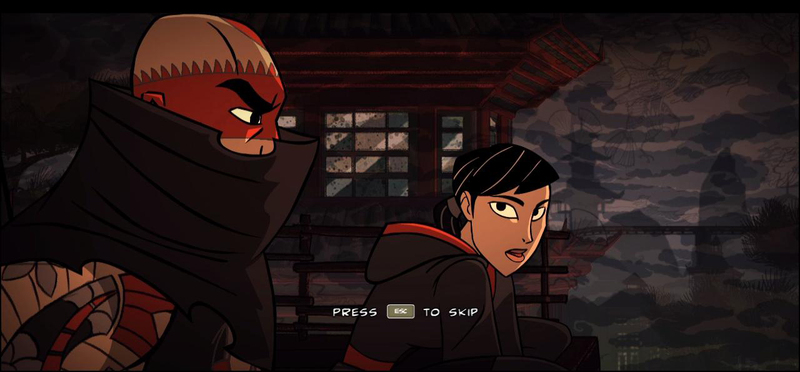
Mission intro movies clearly indicate that the art direction is inspired by Genndy Tartakovsky's works.
More importantly, the entire art direction is built around the interplay of light and shadow. Whether you explore high-tech corporate buildings, an Eastern European castle, a derelict Arabian city or an oriental palace, you will always get the sense of prevalent darkness and the relative security it offers. This is contrasted with the danger of light, as your avatar and your surroundings change when they are illuminated. In Mark of the Ninja the art direction ceases to be just a background and becomes an integral gameplay feature, which speaks volumes about the amount of polish the product received. Few other contemporary games manage to take advantage of this asset equally strongly.
Mark of the Ninja excels in the aural department as well. Environmental noises are convincing, and similarly to light and shadow they play an important role in gameplay. Every sound can potentially alert you enemies - even the squeaking of the mice you disturbed when walking by, or the ruffling of birds perched on a tree branch you clung to. There is a caveat, however. Due to the sheer importance of environmental sounds, the music in Mark of the Ninja is entirely in the background, nearly inconspicuous. Its ambient, creepy repetitive tones punctuate every step you take and highlight the contemplative nature of the game. As soon as things go awry the music gains pace and accentuates the imminent danger. In general, it fits the context of the game perfectly well, but it has to be admitted that as a separate set of soundtracks it would not sound very compelling.
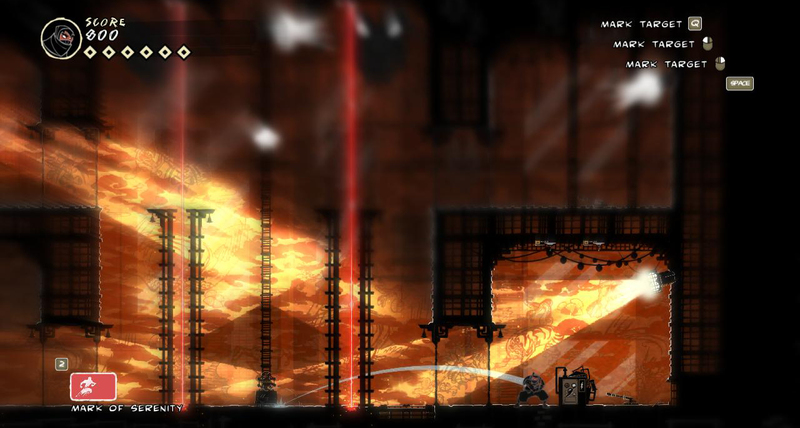
Much of the gameplay revolves around the interplay between light and shadows. Sometimes that creates visually astounding effects.
Gameplay
Similar to every other good representative of stealth genre, Mark of the Ninja is a peculiar kind of puzzle game under the hood - one which allows multiple solutions to a single problem. The general rule remains the same: go from point A to B, preferably without being spotted. Other than that, the cuffs are off. In the span of 10 missions, which constitute approximately 10 hours of gameplay, you will face countless challenges, taking a number of discrete forms.
Environments, or All war is deception
In Mark of the Ninja the greatest challenge comes from environments. The level design impresses with the number of options available to the player. Nonetheless, while there may be many paths leading to the same objective, not all of them are equally viable and they may require different approaches coupled with good reflexes and timing.
This is both due to the architecture of locations and the presence of various contraptions embedded into them that will make your work more difficult. Over the course of the game you will come across motion sensors, lasers, noise detectors, concealed proximity mines, and the greatest enemy of every ninja - light sources. On the flipside, there are also vents, dark hallways, large flower pots you can use as hiding spots and poles you can swiftly hook onto to cover large distances in a flash. All of them together are set up to create an elaborate logical puzzle, which signifies very solid, thought-out level design.
There’s a small niggle, however. As interesting as locations are, it is evident that their credibility was sacrificed for gameplay considerations - some of them have simply impossible architecture, seemingly built only to make things more difficult or convenient for you. This is not very important in a 2D platformer, but fans of the Thief series may see this as a little bit jarring.
Your enemy is your best friend
In a stealth game, much of the difficulty of a level stems from the wildlife that populates it. For this reason, in contrast with most platformers, enemies in Mark of the Ninja are a grave threat, but only if you let them be one. Your ninja may possess close to superhuman abilities, but a single burst from a machine gun - the guards’ default weapon - is enough to put him down. Consequently, facing enemies head-on is practically never the smartest idea. You may be able to stun and kill one guard, but the fight will cause commotion and inevitably attract attention of others, who will make a short work of you. Thus, usually your best option is distracting the guards and either avoiding confrontation or performing a stealth kill and quickly hiding the body, before the next patrol finds it.
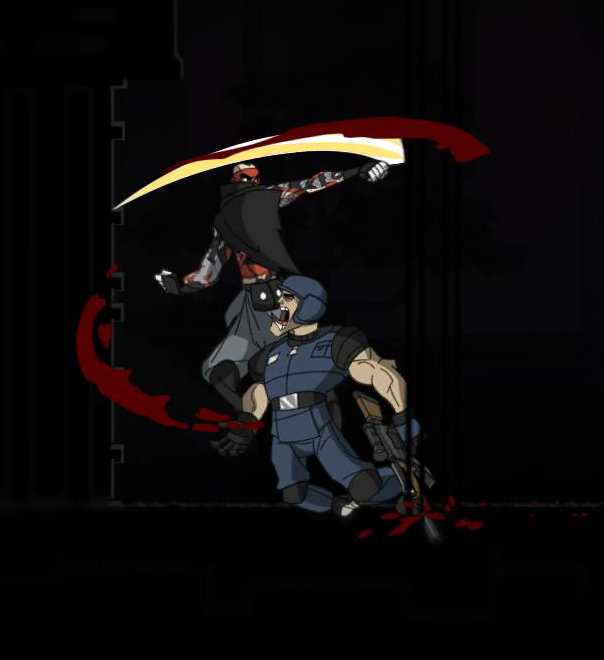
Killing enemies is a messy business. Our ninja appears to have some unresolved anger issues.
The game features many types of foes, who possess a variety of abilities. Dogs can sniff you out from hiding spots, elite guards are impossible to stealth-kill unless stunned, heavy troopers carry riot shields which make them invulnerable to your normal attacks, snipers can spot you from afar in the total darkness, and even regular guards carry flashlights which can momentarily reveal your position to everyone on the screen. As a result, all enemies remain a threat throughout the game and the composition as well as placement of their forces is the key factor in gameplay.
The enemy AI is satisfactory for the most part. Your foes react to noise and visual contact from a far distance - they go to the place of disturbance to check it out. Being discovered triggers an alarm whereby the enemies from the entire screen rush to your last seen position and inspect the area. Interestingly enough, guards have basic psychology. By default they are relaxed, patrol the area in a stroll, smoke cigarettes and chat with one another. When they are agitated, they raise their gun and carefully approach the source of the disturbance. If they spot you they become alarmed, hold the gun at the ready and move at a brisk pace - they will remain in that mode even if the alarm is called off. Lastly when they witness something horrifying, e.g. see their ally drop dead in a gruesome “accident”, they fly into panic and start shooting blindly around, possibly killing other guards.
Taking advantage of these psychological states is one of the cornerstones of gameplay. You will find yourself acting akin to an evil genius, exploiting the fears of your puppets and having them do exactly what you want: from turning their gazes away from the path to your goal, to disabling security systems for you, to killing their own allies.
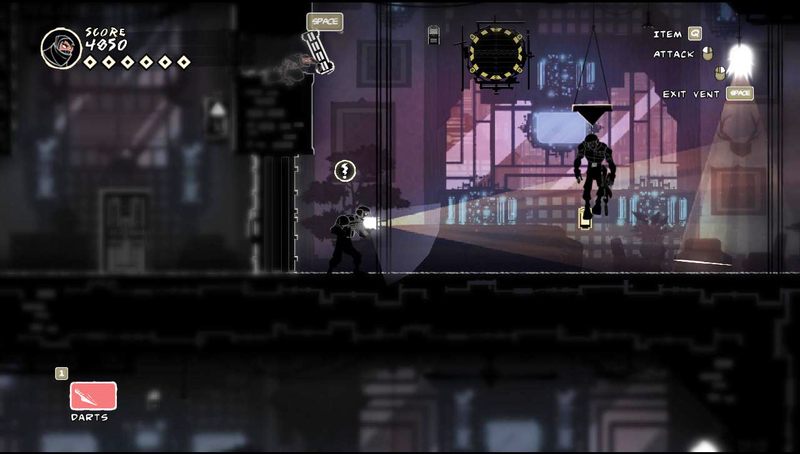
Terrorizing guards is one of the unique aspects of Mark of the Ninja. Here the poor thing is not even shooting in the right direction. He is in for a major surprise.
There is but one problem with the AI. Sometimes it does not react to changes in environment the way it should, because it is not scripted to do so. While the noise of breaking glass puts the enemies on alert, the sight of light source they technically see going out does not provoke any reaction. The same applies to you switching off that sophisticated motion detection system and opening the doors to that secret vault just behind the guards’ backs. This does not appear to be an oversight - it is clearly done for the sake of game balance. Nonetheless it feels as if in such a conundrum Mark of the Ninja tried to make the gameplay easier at all cost.
Character progression
The nameless ninja you control has many abilities which help him achieve his goals. By default he can climb up most vertical surfaces, jump down from extreme heights, swing on a grapple hook, and sneak noiselessly. He can also stealth-kill most guards with a single thrust of a sword and throw up to three darts in a time-stop mode. Later on you will gain access to more tools and abilities, which will open new solutions to numerous challenges you face.
Mark of the Ninja features a character progression system based around developing character abilities and equipment as opposed to stats. In fact, there is only one numerical parameter describing your ninja - hit points. Everything else you can do is determined by your own expertise with the abilities, and items you have from the start or acquire in the course of your playthrough.
After every stage your efforts are evaluated, and based on your actions you are rewarded with ability points. Ability points are given in three distinct categories - three points in each. First is your overall performance in the form of a score. It is very similar to classic experience points system with a slight twist – whereas during the mission you are rewarded for killing enemies, after the mission is over the game gives you a substantial bonus if no enemy was murdered and no alarm was raised. Second are the side objectives - predetermined stunts you managed to pull off in the mission. Finally, you awarded points corresponding to the amount of scrolls telling the story of your clan that you have found in secret areas scattered around the level.
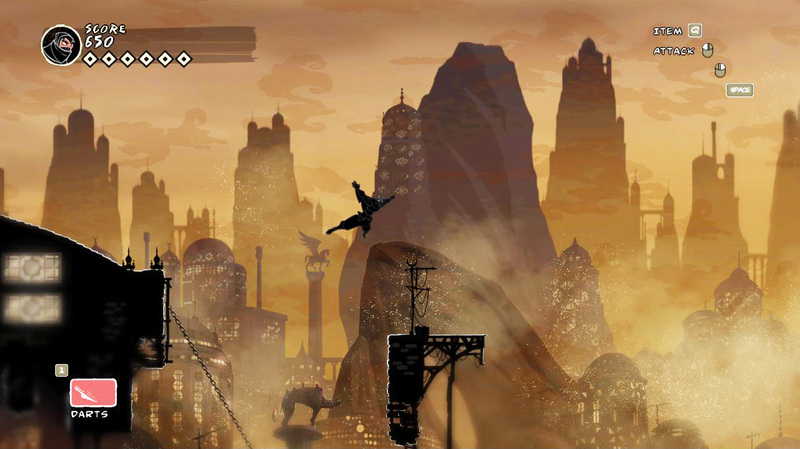
New abilities offer a variety of gameplay options. Here an armour upgrade lets you float on the wind to reach an otherwise inaccessible area.
The points can be spent on new techniques and acquiring or upgrading your ninja gear. Most abilities offer you new, inventive and gruesome ways to stealth-kill your enemies, but there are a few which improve your mobility and add extra crowd-control options. There are also some semi-supernatural techniques unlocked as you gain extra ninja marks over the course of the game.
Items are subdivided in two categories: distraction and attack tools. As the name denotes, the distraction tools are non-lethal items which draw the guards’ attention elsewhere or let you hide in plain sight if you are fast enough. By contrast, attack items by definition make killing more efficient or cause the environment to deal damage.
The game also features different suits of armour unlocked for completing specific categories of side objectives. They add extra benefits such as the ability to mutilate corpses or run without sound. There is always some tradeoff to them, however; for example, they can switch off your time-stop skills or prevent you from stealth-killing your enemies.
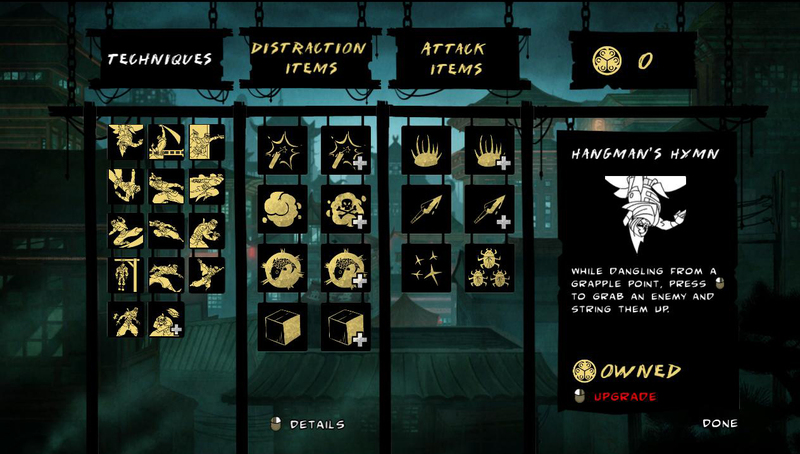
Character upgrade screen. It may not seem like much, but each of these upgrades can impact your gameplay style significantly.
Unfortunately, there are two problems which undermine this elegant system. First, although the developers clearly attempted to strike balance between a stealth-kill approach and ghosting levels without putting anyone in harm’s way, they did not quite manage to achieve that. Finding new, devious ways to dispose of your foes is simply more satisfying than breezing past them unnoticed, and it is often a much more convenient solution, without any real drawback. Other than personal satisfaction and a bit more XP, there is little incentive to ghost a level. In other words the changes in character progression, albeit welcome, are not enough to balance the two approaches.
This is additionally exacerbated by the existence of side objectives that rule out the purely stealthy approach, at least on your first playthrough. You will be faced with the tasks such as “kill 3 enemies with environmental objects” or “make two guards kill one another”. While this can be seen as a non-invasive mechanic encouraging the player to experiment with various techniques, it also highlights the kind of shift to lethal gameplay that not everyone might like. Additionally, the way they are phrased puts them out of the context of the main objective - they feel like Steam achievements rather than important mission goals.
The broader picture
If there is a single area where Mark of the Ninja truly shines, it is the way it takes every mechanical aspect and puts it in a coherent whole. The level and enemy design, as well as character progression, are placed into context and tied together so tightly that it is often impossible to discriminate between them. In Mark of the Ninja you witness synergy - the overall experience is better than the sum of its parts. This is clearly visible in the mission structure.
Mark of the Ninja knows how to spice up the tired “go from A to B” formula - there is never a dull moment. The game provides variety at every corner, even if it stems from the most rudimentary changes in level architecture, enemy positioning and placement of light sources. It also introduces side-challenges specific to the given area, such as storm with flashes of lighting revealing your position or a sandstorm which obscures your vision when outdoors. The structure of levels and the contemplative pace of the game encourage careful planning, but your schemes must be executed with flair and speed.
There are a few instances in the game where you play under time constraints, e.g. you are required to survive a specified amount of time and then make your escape. Mark of the Ninja benefits from these moments, but I feel like it does not introduce them often enough. Unfortunately, the game is not really willing to play around with this model - to force your hand and encourage quick thinking.
It has to be admitted that although Mark of the Ninja features numerous interesting puzzles, most of them are not extremely complex, and they are easy to solve even with a plain trial-and-error approach, if only due to the fact that many of them have multiple solutions. This may come as a bitter disappointment to veterans of countless dungeon crawling campaigns used to deviously unfair challenges. Furthermore, the game could benefit from slightly better AI and extra difficulty settings.
Mark of the Ninja also features a New Game+ mode, which raises the bar considerably. It reduces your line of sight to the front of your character, making it much more difficult to time your actions, and requiring you to rely on your ears and special abilities to locate possible hazards. Regrettably, it is available only after the first successful playthrough.
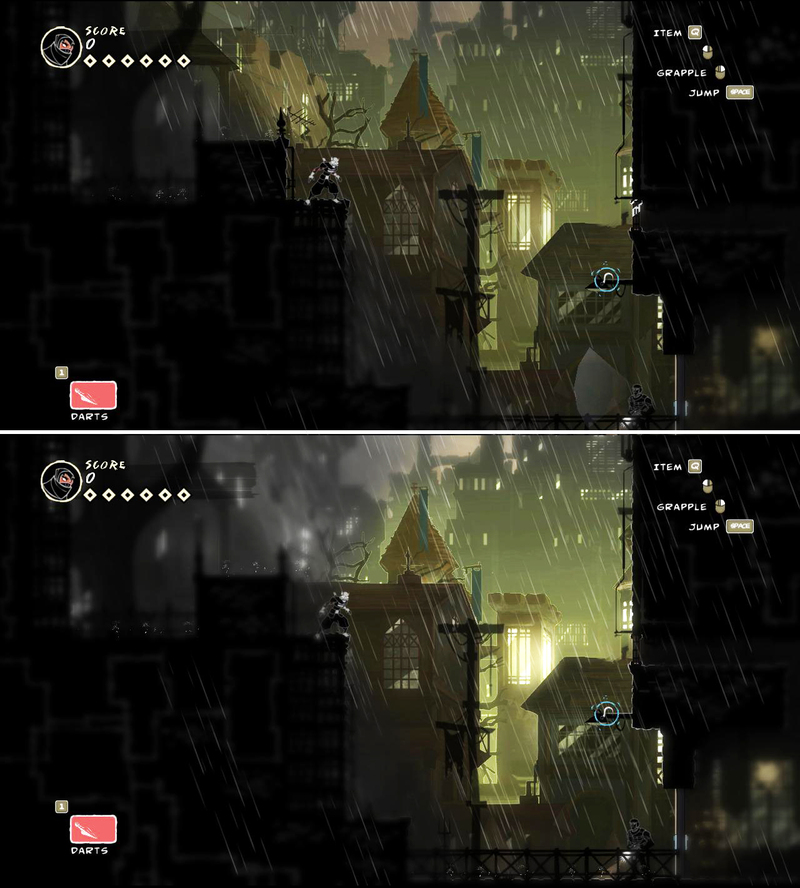
Side by side comparison of Normal (above) and New Game+ (below) modes. Notice the blur behind the character in the second pic.The character can see only what is in front of him. This makes a great difference.
Conclusion
Mark of the Ninja is a very solid game. “Focused” is the keyword that underlies its every aspect. True, it targets a very specific niche, ignoring certain facets of gameplay which could not work in a 2D format. Nevertheless, within the limited framework it establishes, it gives no quarter - it does not know what “compromise” means, opting to be a very polished, singular experience rather than everything to everyone. It comes from developers who clearly know their own limitations, but instead of being discouraged, they are eager to work around them to deliver a thoroughly unique experience.
Mark of the Ninja is a model example of what happens when unrelenting passion meets ingenious foresight. It does have some shortcomings, but most of them result from a curious paradox: it is a rare example of a game that leaves you craving for more, even though from the very first moments it offers you plenty. It is the game a true fan of stealth games should not ignore. That it also happens to be one of the best RPGs this year comes as an unexpected bonus.

P.S. Many thanks to sea for his invaluable help!
Over the past few years, fans of stealth games did not have many opportunities to indulge in their favourite pastime. Indeed, it can be argued that more contemplative and focused gameplay did not suit the demand of the modern video game market. Only recently developers and gamers started to rediscover this niche and the underexplored potential it offers. Not long ago, community member JarlFrank shared with us his impressions of Dishonored - which he deemed a flawed but fun representative of stealth genre. Square Enix just released their new take on the Hitman franchise. In between these two big-budget giants, however, a challenger appeared - a master of stealth, whose inconspicuous nature makes him all the more deadly.
Mark of the Ninja is a game developed by Klei Entertainment studios. The company is known for Shank 1 and 2 - a series of 2D brawlers characterized by brutal, gory combat and fast engaging action, all presented in gorgeous cartoon visual style. To an extent Mark of the Ninja follows in their footsteps, inheriting 2D environments, gore and distinctive graphics. However, from the very first seconds it becomes evident that it also shuns their arcade approach, favouring flair, style and shadows over brute force. Mark of the Ninja is a unique 2D stealth platformer, which in spite of simplicity, manages to impress on a level that few AAA titles do these days.
Let me tell you a story…
The plot of Mark of the Ninja is very simple, but that does not mean it is poorly told. We first meet our hero as he is awakened in the middle of the night by a fellow ninja. It turns out his sanctuary is under attack, and his only choice is to sneak past the overwhelming odds to save his master. Not long after, he is selected to exact vengeance on enemies of his clan. In order to do so, he is given mysterious marks - tattoos which enhance ninja abilities. Further down the line, he will be faced with various twists and turns, which put him in a dire situation.
The story Mark of the Ninja tells is hardly original. However, it is also well executed with the plot remaining surprisingly consistent and coherent. At times it can be subtle, with very few – yet, on closer inspection, still-apparent – clues foreshadowing its direction. It never turns into nonsense, and never gets in the way of gameplay, which stands in direct contrast to many other recent titles.
The beauty of shadows
Graphically, Mark of the Ninja is reminiscent of Genndy Tartakovsky’s cartoons, with Samurai Jack being the most obvious inspiration for the developers. However, the authors manage to add their own individual touches. As a consequence of the game’s cartoon style, human characters tend to be fairly simple, but objects and backgrounds are given much more detail and believability. This style is further reinforced by the top quality of animations. These are very fluid - when the character crawls the ducts, creeps in shadows or performs a stealth kill, you can witness even very small details in his physiognomy change. The same applies to every other character and moving object in the game.

Mission intro movies clearly indicate that the art direction is inspired by Genndy Tartakovsky's works.
More importantly, the entire art direction is built around the interplay of light and shadow. Whether you explore high-tech corporate buildings, an Eastern European castle, a derelict Arabian city or an oriental palace, you will always get the sense of prevalent darkness and the relative security it offers. This is contrasted with the danger of light, as your avatar and your surroundings change when they are illuminated. In Mark of the Ninja the art direction ceases to be just a background and becomes an integral gameplay feature, which speaks volumes about the amount of polish the product received. Few other contemporary games manage to take advantage of this asset equally strongly.
Mark of the Ninja excels in the aural department as well. Environmental noises are convincing, and similarly to light and shadow they play an important role in gameplay. Every sound can potentially alert you enemies - even the squeaking of the mice you disturbed when walking by, or the ruffling of birds perched on a tree branch you clung to. There is a caveat, however. Due to the sheer importance of environmental sounds, the music in Mark of the Ninja is entirely in the background, nearly inconspicuous. Its ambient, creepy repetitive tones punctuate every step you take and highlight the contemplative nature of the game. As soon as things go awry the music gains pace and accentuates the imminent danger. In general, it fits the context of the game perfectly well, but it has to be admitted that as a separate set of soundtracks it would not sound very compelling.

Much of the gameplay revolves around the interplay between light and shadows. Sometimes that creates visually astounding effects.
Gameplay
Similar to every other good representative of stealth genre, Mark of the Ninja is a peculiar kind of puzzle game under the hood - one which allows multiple solutions to a single problem. The general rule remains the same: go from point A to B, preferably without being spotted. Other than that, the cuffs are off. In the span of 10 missions, which constitute approximately 10 hours of gameplay, you will face countless challenges, taking a number of discrete forms.
Environments, or All war is deception
In Mark of the Ninja the greatest challenge comes from environments. The level design impresses with the number of options available to the player. Nonetheless, while there may be many paths leading to the same objective, not all of them are equally viable and they may require different approaches coupled with good reflexes and timing.
This is both due to the architecture of locations and the presence of various contraptions embedded into them that will make your work more difficult. Over the course of the game you will come across motion sensors, lasers, noise detectors, concealed proximity mines, and the greatest enemy of every ninja - light sources. On the flipside, there are also vents, dark hallways, large flower pots you can use as hiding spots and poles you can swiftly hook onto to cover large distances in a flash. All of them together are set up to create an elaborate logical puzzle, which signifies very solid, thought-out level design.
There’s a small niggle, however. As interesting as locations are, it is evident that their credibility was sacrificed for gameplay considerations - some of them have simply impossible architecture, seemingly built only to make things more difficult or convenient for you. This is not very important in a 2D platformer, but fans of the Thief series may see this as a little bit jarring.
Your enemy is your best friend
In a stealth game, much of the difficulty of a level stems from the wildlife that populates it. For this reason, in contrast with most platformers, enemies in Mark of the Ninja are a grave threat, but only if you let them be one. Your ninja may possess close to superhuman abilities, but a single burst from a machine gun - the guards’ default weapon - is enough to put him down. Consequently, facing enemies head-on is practically never the smartest idea. You may be able to stun and kill one guard, but the fight will cause commotion and inevitably attract attention of others, who will make a short work of you. Thus, usually your best option is distracting the guards and either avoiding confrontation or performing a stealth kill and quickly hiding the body, before the next patrol finds it.

Killing enemies is a messy business. Our ninja appears to have some unresolved anger issues.
The game features many types of foes, who possess a variety of abilities. Dogs can sniff you out from hiding spots, elite guards are impossible to stealth-kill unless stunned, heavy troopers carry riot shields which make them invulnerable to your normal attacks, snipers can spot you from afar in the total darkness, and even regular guards carry flashlights which can momentarily reveal your position to everyone on the screen. As a result, all enemies remain a threat throughout the game and the composition as well as placement of their forces is the key factor in gameplay.
The enemy AI is satisfactory for the most part. Your foes react to noise and visual contact from a far distance - they go to the place of disturbance to check it out. Being discovered triggers an alarm whereby the enemies from the entire screen rush to your last seen position and inspect the area. Interestingly enough, guards have basic psychology. By default they are relaxed, patrol the area in a stroll, smoke cigarettes and chat with one another. When they are agitated, they raise their gun and carefully approach the source of the disturbance. If they spot you they become alarmed, hold the gun at the ready and move at a brisk pace - they will remain in that mode even if the alarm is called off. Lastly when they witness something horrifying, e.g. see their ally drop dead in a gruesome “accident”, they fly into panic and start shooting blindly around, possibly killing other guards.
Taking advantage of these psychological states is one of the cornerstones of gameplay. You will find yourself acting akin to an evil genius, exploiting the fears of your puppets and having them do exactly what you want: from turning their gazes away from the path to your goal, to disabling security systems for you, to killing their own allies.

Terrorizing guards is one of the unique aspects of Mark of the Ninja. Here the poor thing is not even shooting in the right direction. He is in for a major surprise.
There is but one problem with the AI. Sometimes it does not react to changes in environment the way it should, because it is not scripted to do so. While the noise of breaking glass puts the enemies on alert, the sight of light source they technically see going out does not provoke any reaction. The same applies to you switching off that sophisticated motion detection system and opening the doors to that secret vault just behind the guards’ backs. This does not appear to be an oversight - it is clearly done for the sake of game balance. Nonetheless it feels as if in such a conundrum Mark of the Ninja tried to make the gameplay easier at all cost.
Character progression
The nameless ninja you control has many abilities which help him achieve his goals. By default he can climb up most vertical surfaces, jump down from extreme heights, swing on a grapple hook, and sneak noiselessly. He can also stealth-kill most guards with a single thrust of a sword and throw up to three darts in a time-stop mode. Later on you will gain access to more tools and abilities, which will open new solutions to numerous challenges you face.
Mark of the Ninja features a character progression system based around developing character abilities and equipment as opposed to stats. In fact, there is only one numerical parameter describing your ninja - hit points. Everything else you can do is determined by your own expertise with the abilities, and items you have from the start or acquire in the course of your playthrough.
After every stage your efforts are evaluated, and based on your actions you are rewarded with ability points. Ability points are given in three distinct categories - three points in each. First is your overall performance in the form of a score. It is very similar to classic experience points system with a slight twist – whereas during the mission you are rewarded for killing enemies, after the mission is over the game gives you a substantial bonus if no enemy was murdered and no alarm was raised. Second are the side objectives - predetermined stunts you managed to pull off in the mission. Finally, you awarded points corresponding to the amount of scrolls telling the story of your clan that you have found in secret areas scattered around the level.

New abilities offer a variety of gameplay options. Here an armour upgrade lets you float on the wind to reach an otherwise inaccessible area.
The points can be spent on new techniques and acquiring or upgrading your ninja gear. Most abilities offer you new, inventive and gruesome ways to stealth-kill your enemies, but there are a few which improve your mobility and add extra crowd-control options. There are also some semi-supernatural techniques unlocked as you gain extra ninja marks over the course of the game.
Items are subdivided in two categories: distraction and attack tools. As the name denotes, the distraction tools are non-lethal items which draw the guards’ attention elsewhere or let you hide in plain sight if you are fast enough. By contrast, attack items by definition make killing more efficient or cause the environment to deal damage.
The game also features different suits of armour unlocked for completing specific categories of side objectives. They add extra benefits such as the ability to mutilate corpses or run without sound. There is always some tradeoff to them, however; for example, they can switch off your time-stop skills or prevent you from stealth-killing your enemies.

Character upgrade screen. It may not seem like much, but each of these upgrades can impact your gameplay style significantly.
Unfortunately, there are two problems which undermine this elegant system. First, although the developers clearly attempted to strike balance between a stealth-kill approach and ghosting levels without putting anyone in harm’s way, they did not quite manage to achieve that. Finding new, devious ways to dispose of your foes is simply more satisfying than breezing past them unnoticed, and it is often a much more convenient solution, without any real drawback. Other than personal satisfaction and a bit more XP, there is little incentive to ghost a level. In other words the changes in character progression, albeit welcome, are not enough to balance the two approaches.
This is additionally exacerbated by the existence of side objectives that rule out the purely stealthy approach, at least on your first playthrough. You will be faced with the tasks such as “kill 3 enemies with environmental objects” or “make two guards kill one another”. While this can be seen as a non-invasive mechanic encouraging the player to experiment with various techniques, it also highlights the kind of shift to lethal gameplay that not everyone might like. Additionally, the way they are phrased puts them out of the context of the main objective - they feel like Steam achievements rather than important mission goals.
The broader picture
If there is a single area where Mark of the Ninja truly shines, it is the way it takes every mechanical aspect and puts it in a coherent whole. The level and enemy design, as well as character progression, are placed into context and tied together so tightly that it is often impossible to discriminate between them. In Mark of the Ninja you witness synergy - the overall experience is better than the sum of its parts. This is clearly visible in the mission structure.
Mark of the Ninja knows how to spice up the tired “go from A to B” formula - there is never a dull moment. The game provides variety at every corner, even if it stems from the most rudimentary changes in level architecture, enemy positioning and placement of light sources. It also introduces side-challenges specific to the given area, such as storm with flashes of lighting revealing your position or a sandstorm which obscures your vision when outdoors. The structure of levels and the contemplative pace of the game encourage careful planning, but your schemes must be executed with flair and speed.
There are a few instances in the game where you play under time constraints, e.g. you are required to survive a specified amount of time and then make your escape. Mark of the Ninja benefits from these moments, but I feel like it does not introduce them often enough. Unfortunately, the game is not really willing to play around with this model - to force your hand and encourage quick thinking.
It has to be admitted that although Mark of the Ninja features numerous interesting puzzles, most of them are not extremely complex, and they are easy to solve even with a plain trial-and-error approach, if only due to the fact that many of them have multiple solutions. This may come as a bitter disappointment to veterans of countless dungeon crawling campaigns used to deviously unfair challenges. Furthermore, the game could benefit from slightly better AI and extra difficulty settings.
Mark of the Ninja also features a New Game+ mode, which raises the bar considerably. It reduces your line of sight to the front of your character, making it much more difficult to time your actions, and requiring you to rely on your ears and special abilities to locate possible hazards. Regrettably, it is available only after the first successful playthrough.

Side by side comparison of Normal (above) and New Game+ (below) modes. Notice the blur behind the character in the second pic.The character can see only what is in front of him. This makes a great difference.
Conclusion
Mark of the Ninja is a very solid game. “Focused” is the keyword that underlies its every aspect. True, it targets a very specific niche, ignoring certain facets of gameplay which could not work in a 2D format. Nevertheless, within the limited framework it establishes, it gives no quarter - it does not know what “compromise” means, opting to be a very polished, singular experience rather than everything to everyone. It comes from developers who clearly know their own limitations, but instead of being discouraged, they are eager to work around them to deliver a thoroughly unique experience.
Mark of the Ninja is a model example of what happens when unrelenting passion meets ingenious foresight. It does have some shortcomings, but most of them result from a curious paradox: it is a rare example of a game that leaves you craving for more, even though from the very first moments it offers you plenty. It is the game a true fan of stealth games should not ignore. That it also happens to be one of the best RPGs this year comes as an unexpected bonus.

P.S. Many thanks to sea for his invaluable help!
There are 121 comments on Stealth Game Codex Review: Mark of the Ninja











